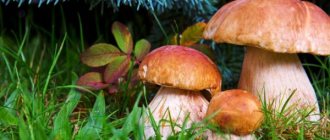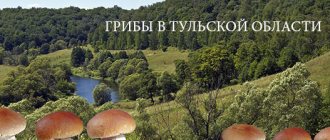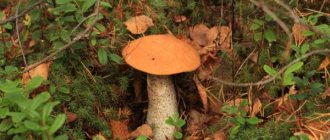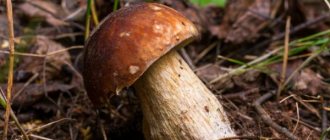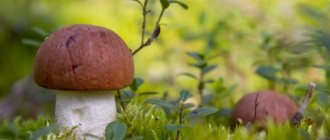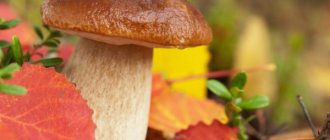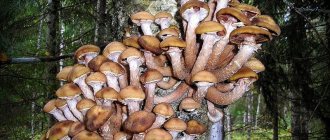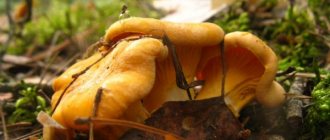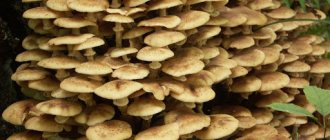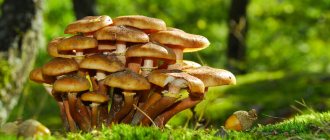Edible mushrooms
When going to the forest, you need to first familiarize yourself with the list of edible mushrooms. It will be useful to take with you a small brochure with their images so as not to be mistaken. Porcini mushrooms are of particular value in the Trans-Baikal Territory. Boletus, honey mushrooms, boletus, boletus, saffron milk caps, chanterelles, etc. also grow there.
Borovik
There are several varieties of porcini mushroom. They belong to the highest - category 1, and such finds are especially valued by mushroom pickers. Its other name is boletus. The older the mushroom, the flatter its initially rounded cap becomes.
Despite the name of the species, it is brown. Even when dried, its color remains unchanged. It is velvety to the touch, with a diameter of up to 35 cm. There are rare specimens with a diameter of 60 cm.
The stem is gray or dark brown, its height reaches 12 cm. In temperate climates, these edible mushrooms of Transbaikalia ripen at the end of May, June and grow until the end of autumn. The rainier it is, the more forest gifts you can collect.
Irina Selyutina (Biologist):
In Rus', “white” were mushrooms whose flesh did not change its color during heat treatment, but remained, so to speak, “lifetime.” They were called so in contrast to “black” mushrooms - mushrooms, which, although very good in cooked dishes, but whose flesh darkened when processed. It is difficult to name the exact time when the phrase “ceps” became a species. Today, the forms of boletus mushrooms differ in the color of the caps, which depends on the habitat and timing of appearance.
Boletus is popular due to its beneficial properties. It is noted that it is effective for cardiovascular diseases, the presence of parasites, problems with the genitourinary system and tuberculosis.
Honey mushrooms
The peculiarity of honey mushrooms is their place of growth. In most cases, they grow on stumps and trees (both living and dried). Honey mushrooms are also rarely found in the meadow.
In appearance, they resemble umbrellas: the cap is semicircular, flattened at the bottom, and has a tubercle at the very top. Diameter – up to 10 cm. They differ from inedible honey mushrooms by the presence of small scales. True, on older specimens they become less noticeable, but you can’t eat them either. The cap is light and covered with mucus. The leg grows up to 18 cm in length.
To be sure that your basket contains only real honey mushrooms, it is better to collect only young mushrooms, which have all the distinctive features.
Grow next to trees such as:
Most often, honey mushrooms are eaten pickled or fried. They appear closer to the beginning of autumn.
Boletus
Despite its name, boletus grows not only under aspen, but still more often under it. You can meet it at the roots of pines, birches, oaks and spruces. Grows in groups or singly. It is similar in appearance to the boletus mushroom, but its cap is bright orange, which is why it is called the red mushroom, red mushroom, red mushroom and red mushroom.
It grows up to 20 cm in height, some specimens weigh up to 2 kg. The hat is semicircular, with edges that fit tightly to the stem. The surface is velvety, without mucus, with black or brown scales. When cut, the flesh usually turns blue and this is what scares novice mushroom pickers. Therefore, just take into account the presence of this feature and feel free to put the mushroom in the basket. Boletuses are ready for harvesting in June.
Saffron milk caps
There are several types, but the most popular are red and spruce saffron milk caps. They grow near coniferous trees, in well-lit places. Their location does not change from year to year. More often they grow in small groups.
The color of the cap is orange, its diameter is up to 18 cm. The surface is covered with a thin layer of mucus. The pulp is aromatic; when pressed, orange juice is released, which oxidizes when exposed to air and turns green. The stem of saffron milk caps grows up to 10 cm in length and 2 cm in diameter. It is the same color as the hat. Mushrooms grow from early July to September.
Nutritionists consider saffron milk caps to be a fairly high-calorie product, superior in this regard to beef, chicken, eggs and herring.
Chanterelles
Chanterelles grow after the rain
Another red gift of the forest, although some specimens may be yellow. They grow near pines, birches or oaks. Immediately after rain, their number increases significantly. They have an unusual cap shape, the diameter of which ranges from 1 to 7 cm. In the middle of it there is a small depression, and the edges are curved down. The stalk is from 3 to 9 cm long and less than 1 cm wide.
The color of the stem is absolutely identical to the cap. The smell of chanterelles is reminiscent of dried fruit. They grow from early summer until October.
Experiments on growing chanterelles as an agricultural crop on a par with champignons, although they showed success in this area, an insurmountable obstacle to launching into “mass production” was the complete lack of specific taste and aroma of these mushrooms. Therefore, those who like to treat themselves to chanterelles have to go every year in search of these magnificent and tasty gifts of the forest.
Poisonous mushrooms
Poisonous mushrooms are in many ways similar to edible ones. Most of them are noticeable in the forest, but some will have to be examined more carefully to classify them as inedible species.
Fly agaric red
This mushroom is difficult to miss and mistaken for edible. It stands out from others with its red cap with white specks, which can disappear after heavy rains. The fleshy cap grows up to 20 cm in diameter. The leg is white, reaches a height of 20 cm.
Eating this mushroom causes blurred vision, hallucinations, breathing problems and stomach upset. If you do not provide timely assistance to a person in case of poisoning, death is possible.
Irina Selyutina (Biologist):
Amanita muscaria is classified as a hallucinogenic or “magic” mushroom. So in human civilization it is common to call the types of mushrooms that are capable of bringing a person’s consciousness into an altered state - inadequate stimulation of the central nervous system occurs. This is due to the influence of hallucinogens contained in the fruiting bodies, in this case choline, muscarine, hydroxyl acid and muscilin. The red fly agaric, one of the most common species, was known 3500 years ago to the indigenous peoples of the Far North. There were special names for it: among the Chukchi - vanak, among the Evenki - okay. Its shamans used it in small quantities for religious ceremonies related to communication with ancestors and spirits of other worlds. In addition, the red fly agaric also served as a psychostimulant (it activated mental activity and slightly motor activity of a person). Studies conducted quite a long time ago have shown its destructive effect on the psyche and physical degradation of the individual, comparable to the same effect of known narcotic substances.
Mushrooms of the Red Book of Buryatia
Human impact and climate change affect nature, and therefore some types of mushrooms are extremely rare. The Red Book of the Russian Federation and Buryatia includes protected species, the collection and processing of which is prohibited:
| № | Russian name | Latin name | Habitat |
| 1 | Amylocystis lapland | Amylocystis lapponicus | with hr. Barguzinsky (Levaya Frolikha River), Svyatoy Nos (Fertik Bay), Chivyrkuisky Bay (North-Baikal, Barguzinsky districts) |
| 2 | Volvariella volvova | Volvariella volvacea | Southern shore of Lake Baikal |
| 3 | Cordyceps military | Cordyceps militaris | Northern slope of the Khamar-Daban ridge |
| 4 | Lactarius alpine | Lactarius alpinus Peck | Ikatsky, North-Muysky ridges, upper reaches of the Garga River, mouth of the Muya River |
| 5 | White aspen | Leccinum percandidum | Tunka Valley, Khamar-Daban ridge |
| 6 | Inonotus | Inonotus | Near the villages of Mostovka, Yugovo, Ilyinka, some islands on the Selenga River |
| 7 | Umbrella tinder fungus | Polyporus umbellatus | The outskirts of villages and near the city of Kyakhta |
| 8 | Varnished tinder fungus | Ganoderma lucidum | Southern part of the Baikal coast |
| 9 | Chosenia tinder fungus | Polyporus choseniae | Northern slope of Khamar-Daban |
| 10 | False birch polypore | Polyporus pseudobetulinus | Khamar-Daban ridge in Kabansky district, outskirts of the village of Zolotoy Klyuch |
| 11 | Endoptychus agaricoides | Endoptychum agaricoides | The village of Zun-Murino in the Tunkinsky district, Tataurovo, Tarbagatai, environs of the city of Kyakhta |
| 12 | Leukofoliote wood | Leucopholiota lignicola | Tunkinskaya Valley |
| 13 | Mutinus canis | Mutinus caninus | The village of Zun-Murino, Arshan, the southern shore of Lake Baikal, the vicinity of the station. Tankhoy |
| 14 | Tyromyces kmeta | Tyromyces kmetii | Village of Oymur, Kabansky district |
| 15 | Morel is questionable | Gyromitra ambigua | Davsha Bay, mouth of the Snezhnaya River, Baikal coast |
| 16 | Double net carrier | Dictyophora duplicata | Zun-Murino, valley of the Kyngarga River, Arshan resort |
| 17 | Giant raincoat | Langermannia gigantea | Tunkinskaya Valley |
| 18 | Trametes conquiniferous | Trametes conchifer | Villages Yugovo, Ilyinka, Tataurovo |
Mushrooms of unusual shape
Everyone is accustomed to the fact that the mushroom cap is spherical or slightly flattened, but the specimens growing in the Trans-Baikal Territory can surprise with their unusual shapes.
Hydnellum Peca
He looks in such a way that if you don't know, you can be quite scared. It is white in color, with a velvety surface, becoming browner over time. The shape is heterogeneous, with depressions and bumps. In the depressions there are red drops, similar to blood.
It grows up to 10 cm. The legs are almost invisible behind the cap, its height is no more than 2 cm. The color is white. The smell of the pulp is a bit like strawberries. Its taste is extremely bitter, which makes the mushroom completely inedible.
The mushroom is called "bleeding tooth" because the older it gets, the more white "sharp" growths form on the underside of the cap. Presumably, it is characterized by partial feeding on insects, which adhere to its surface with a bright and viscous substance. Grows from September to November.
Puffball mushrooms
Another Transbaikalia mushroom of an unusual shape, resembling an asterisk, was found on the territory of the local history museum. Mycologists classified it as a puffball mushroom from the genus Zvezdovik of the Zvezdovik family. The appearance of the fungus gradually changes as it develops. The exoperidium opens with regular radial lobes, in contrast to the endoperidium, which can open in a variety of ways. It is thanks to the exoperidium that the mushrooms got their name - starworts or earthen stars.
It is classified as a conditionally edible mushroom; it can only be eaten when it is a ball. At this time, it is almost completely immersed in the soil and is extremely difficult to find.
In addition to these unusual ones, in the territory of Transbaikalia there are also puffball mushrooms that are familiar in appearance, in which the stem smoothly flows into the cap. They belong to the Raincoat genus from the Champignonaceae family. Their cap is in the shape of a ball or pear, the flesh is elastic and white, like the surface of the mushroom itself. There are small spikes on the surface. It can grow anywhere, especially loves places with a lot of toxins (near roads or near industrial plants). Puffballs are classified as conditionally edible mushrooms, which can be eaten only while they are in the stage of a white ball with dense pulp.
If you're going into the forest, put on a protective suit!
Mikhail Bolobnov, manager of the ZabaikalSPETSOZhDA store:
– People who like frequent and long walks in the forest will need a protective suit against ticks and blood-sucking insects. Anti-encephalitis suits differ from ordinary hiking suits by the presence of mechanical traps, a mosquito net with a zipper and thick cuffs. Often, costume models are treated with a special substance that repels insects.
Author: Valeria Dashieva, Svetlana Namsaraeva
Map of mushroom places
It is better to collect mushrooms away from the city
Any mushrooms that grow along roads, near industrial enterprises and landfills are poisonous. In the Trans-Baikal Territory, when collecting, it is better to give preference to forest areas.
- Tunkinskaya Valley: people go here for milk mushrooms and saffron milk caps. This place is very beautiful, so picking mushrooms there is a real pleasure. They go to the village of Bolshie Koty for them, and get there by boat or on foot. It is recommended to go to the village of Arshan, where you can get healing mineral water.
- The village of Pivovarikha, not far from Irkutsk: this is an excellent option for those who do not want to go far, but plan to return with baskets full of mushrooms. Here you will find moss mushrooms, honey mushrooms and even boletus mushrooms.
- Kachugsky, Goloustnensky, Kultuksky tracts, 105 and 166 km of the Aleksandrovsky tract: here you can find chanterelles, tremors, white mushrooms, moss mushrooms and other varieties of mushrooms.
At all these points you can find not only edible mushrooms, but also poisonous ones: fly agaric, false mushrooms, lines and thin pig - so you cannot relax and lose vigilance.
Collection rules and precautions
Before going into the forest, you need to prepare. Experienced mushroom pickers know the subtleties that make “quiet hunting” easier.
- Bags are not suitable for collecting: due to their insufficient density, the mushrooms can be damaged and deteriorate due to lack of air circulation. It is better to take with you a large basket or basket with good breathability. A bucket will also work.
- It's worth grabbing a mushroom atlas. This will help distinguish good mushrooms from inedible ones.
- When in doubt, do not take the mushroom. Never forget the first rule of a mushroom picker: if you’re not sure about the quality of a mushroom, don’t take it, pass by.
- You need to go into the forest in closed clothes and comfortable shoes (they should not be sandals or sneakers).
- You should not try raw mushrooms.
- If you have children with you, make sure that they are within your visibility and accessibility and also do not have the opportunity to taste the mushroom.
- The collected forest gifts must be prepared as soon as possible. You should not leave them raw for a long time. They are not stored in the refrigerator for longer than a day.
- You can’t pick mushrooms that you haven’t seen before;
- It is forbidden to take soft, old and watery specimens - despite their edibility, they can cause poisoning. Hang their caps on a tree branch - this will enable the spread of spores and the emergence of new myceliums;
- do not pick mushrooms near the road, near chemical or other industrial enterprises - they actively absorb harmful substances from the environment;
- People with gastrointestinal diseases and children under 12 years old should not eat them;
- If, after consumption, nausea, fever, upset stool, or dilated pupils appear, you need to call an ambulance as soon as possible, and while waiting for it, the person should drink 5-6 glasses of water and induce vomiting.
From early spring to late autumn, mushrooms of the Transbaikal region surprise both beginners and experienced “hunters” with their diversity.
Mushrooms of the Transbaikal region
Literature
- Bezrukova E.V. Vegetation and climate of the South of Eastern Siberia in the Late Neopleistocene and Holocene (according to continuous Baikal sections): abstract. ...dis. Doctor of Geography Sciences / E. V. Bezrukova. – Irkutsk, 2000. – 45 p.
- Belova V. A. History of the development of vegetation in the basins of the Baikal rift zone. – M.: Nauka, 1975. – 142 p.
- Belova V. A. Vegetation and climate of the Late Cenozoic in the south of Eastern Siberia. – Novosibirsk: Nauka, 1985. – 160 p.
- Belkova N. L. Taxonomic diversity of the microbial community of the water column of Lake Baikal: abstract. dis. ...cand. biol. Sciences /N. L. Belkova. Vladivostok, 2004. – 22 p.
- Malyshev L.I. Vertical distribution of vegetation on the coast of northern Baikal / L.I. Malyshev // Izv. East Sib. branch of the USSR Academy of Sciences. – 1957. pp. 113–121
- Molozhnikov V.N. Plant communities of the Baikal region / V.N. Molozhnikov. – Novosibirsk: Nauka, 1986. – 271 p.
Edibility Characteristics
There are 4 degrees of edibility of mushrooms in the Transbaikal region:
It all depends on how much heat treatment the forest products need to be subjected to. Only edible ones are suitable for eating raw: russula and champignons.
Conditionally edible specimens are completely safe, but they are not as tasty and aromatic.
Despite the threatening name - “inedible”, these species are not capable of causing much harm to the human body, but they require pre-treatment, which sometimes takes a long time - up to 8 hours (soaking, washing and cooking).
Edible types of mushrooms in Transbaikalia
Transbaikalia is a region rich in forest treasures. There are many plants with unusual names and shapes, edible and inedible mushrooms growing there.
Harvests are harvested from spring until the onset of cold weather. There are many varieties of mushrooms in the region, these include:
- white;
- boletus;
- spruce saffron milk caps;
- boletus;
- milk mushrooms white, gray, black;
- little boletuses (boletus and boletus);
- chanterelles;
- waves;
- boletus;
- honey mushrooms
When and where can you go mushroom hunting?
From July 25 to August 13 inclusive, due to the fire regime in Buryatia, citizens' stay in forests is limited. However, this does not apply to those who simply drive along public roads, visitors to health resorts, recreation centers, children's camps and tourist centers, as well as wild plant gatherers.
RALH published on its website a list of forest districts in which a harvest of wild plants is expected this year, the types of mushrooms growing there, as well as possible volumes and timing of harvesting.
So, in the Barguzinsky forestry in the Kashtak area (Agafonovo village), the harvesting of milk mushrooms, saffron milk caps, boletus and tremors begins on August 10. In September, saffron milk caps will appear in the Okino-Klyuchevsky forestry of the Bichursky district. In July, the collection of boletus began in the Kiretsky forestry, and from August 1 they can be found in the Romanovsky forestry. The collection of milk mushrooms will also begin there. Saffron milk caps and boletus can be collected in August and September in the Selenginsky forestry. Milk mushrooms, boletus and porcini mushrooms are already collected in the Ust-Barguzin forestry - from July to September inclusive.
Obabki
The forests of Transbaikalia are rich in plants
In the Trans-Baikal mixed forests, the largest harvests of obabkov, i.e. boletus and aspen boletuses with large and thick legs.
The boletus has a brownish or bright orange cap. There are tubes located at the bottom, when pressing on them it is easy to notice greenish spots. From boletus mushrooms, despite all their external similarities, boletus mushrooms differ in the blueness of the flesh on the cut.
Boletus caps are lighter, beige-brown. They mainly grow under birch trees, in groves, from June to September. This species makes aromatic soups.
Volnushki
In the Transbaikal region, from June to October, many varieties of trumpets grow. The most popular type is pink wave. The mushroom cap reaches a diameter of 12 cm and has a bulge in the center. The leg is dense, hard and pale pink.
For the growth of the moth, they select mature birch trees and form mycorrhiza with them. They thrive on soils in deciduous and mixed forests.
Volnushki have a peculiar, unusual, pungent taste. They are good to dry, salt or pickle. To remove bitterness, they are pre-soaked. The milky juice comes out and the taste becomes tender and pleasant.
Did you know? In Central and Southern Europe, pink trumpets are not eaten.
White mushrooms
The white mushroom is considered the king of the Transbaikal forests. It has a dense, fleshy leg, thick at the bottom and slightly thinner towards the cap. The cap is convex and large, up to 30 cm. Its color ranges from light cream to brown. The leg is always white. Even after drying, the pulp remains snow-white. This is why the mushroom got its name. The porcini mushroom reproduces well under ferns and in tall thickets of grass.
It grows throughout the region from June to September.
Interesting fact: fly agarics love to be neighbors with this noble family.
Saffron milk caps
There are two types of saffron milk caps in Transbaikalia: ordinary and spruce. Spruce trees are distinguished by large caps with a funnel in the center and dense, yellowish flesh with a noticeable fruity aroma. A natural antibiotic, lactarioviolin, is isolated from the fruiting bodies of camelina (ordinary mushroom), which is capable of suppressing the development of tuberculosis bacillus.
The Trans-Baikal region is famous for its good harvests of saffron milk caps, which grow in pine and spruce forests from the 2nd decade of summer until September.
Chanterelles
Another tasty type of mushroom from the Transbaikal forests is chanterelles. Local housewives call them “red cockerels” because of the shape of the cap, similar to a cockscomb. They are easy to prepare, easy to wash and clean. They do not need pre-treatment. They retain their taste even after freezing.
Their aroma is strong. The body color is orange or peach, bright, with the same color of juice on the cut. These mushrooms are good to collect on slopes and in ravines, near old dead wood. They are not affected by worms.
Irina Selyutina (Biologist):
The fruiting bodies of chanterelles grow very slowly, this becomes especially noticeable in dry weather. This mushroom usually lives in places with underdeveloped grass cover, so it can only be found under or near trees.
In laboratory conditions, it was found that chanterelles form mycorrhizae with pine; in nature, apparently, they can enter into symbiosis with other tree species.
Dangerous counterparts of chanterelles are orange talkers. Their difference is in the thin leg, bright unnatural color, unpleasant odor and appearance of the hymenophore. In the pink talker it is represented by thin plates, while in real chanterelles it is rather thick folds.
Milk mushrooms
In Transbaikalia there are several types of milk mushrooms: white, black and gray, unusual for other regions. Their caps look like a cone or funnel. The edges are slightly curved outward, with a slight wavy frame, similar to lace, inherent to them. Depending on its presence, milk mushrooms are called raw or dry. Dry ones have no frame.
Irina Selyutina (Biologist):
A few facts about milk mushrooms:
- Milk mushrooms are capable of forming mycorrhizae with a number of tree species, in particular birch, spruce and willow.
- For pickling, it is best to use young milk mushrooms, the caps of which do not exceed 7 cm in diameter and the length of the stem is 1 cm.
- In terms of caloric content, milk mushrooms have surpassed meat - for example, the dry matter of the mushroom contains 32% protein.
- In humid weather, moisture accumulates on the cap of the black milk mushroom due to the presence of a hairy edge.
- Paradox: in Poland, black milk mushroom is called toadstool, but is recognized as edible.
- Black milkweed is capable of accumulating cesium radioisotopes in its body and therefore they are considered bioaccumulators of radioactive substances (radiation).
Places of usual growth are conifers or mixed forests. They were given the name “milk mushrooms” because they grow in piles and clusters. These mushrooms skillfully hide in tall thickets of ferns.
Usually milk mushrooms are salted. However, they require long-term pre-soaking (from 2 to 8 hours).
Every year, mushrooms delight the residents of Transbaikalia with a variety of tastes and aromas. The usefulness of the fruits of the forest makes mushroom pickers return to the forest again and again. Quiet hunting from mid-spring to the end of autumn allows you to prepare dishes and provisions for the winter without spending extra money. Varieties of noble porcini mushrooms, “snotty” boletus mushrooms, delicious chanterelles, white milk mushrooms and other equally popular species grow in the forests every year. So 2022 was no exception to the rule! Favorite mushroom places are already waiting for their guests...
Ahead of schedule
Residents of Buryatia cannot be happier now. They publish baskets of boletus and champignons on social networks, and a resident of Babushkina even collected a whole bucket of porcini mushrooms.
– Last year was dry. Berries and nuts did not grow. Due to lack of food, animals fled to people. I remember at the end of August I was picking cucumbers in the garden. I see our cat running from the fence, somehow bowing her head. I looked closer, and she had a chipmunk in her teeth. Manya ate it before my eyes, all that was left of the animal was the tail,” said Babushkina resident Darzhana Tselovalnikova.
But, according to her, the residents of Babushkino are not left without mushrooms even in drought, but now they appeared much earlier.
– We ourselves are in shock. Mushrooms appeared on Baikal a month earlier, at the end of June,” Daria Belousova from Babushkin told us. – Apparently, our coastal humid climate affects the growth of mushrooms. But you shouldn’t be surprised by the early mushrooms this year. Porcini mushrooms grow when the soil warms up well enough. Our soil also retained moisture from the spring, which is why conditions arose for the growth of mushrooms.
Useful tips for beginner mushroom pickers
- 1 tip - friend
For people who prefer to lead an active lifestyle and decide to change a boring hobby to a useful and very exciting one, professionals advise not to go into the forest alone. For the first time, it is better to go on a “quiet hunt” with friends or relatives who are well versed in mushrooms. After all, even the edible fruits of the forest have twin brothers with a poisonous and inedible filling that is not suitable for consumption or canning.
To know the “victim” by sight, you need to read the description, name and photo of the mushrooms printed on the pages of the encyclopedia. This approach will allow you to maintain your health by remembering the distinctive features of the same oil can when collecting.
- Tip 3 - compass or GPS
To avoid getting lost in the forest and get back onto the road, just take a compass with you. It will help you navigate the area without the help of fellow mushroom pickers passing by.
If you decide to go into the forest by car, it is best to leave the car at the entrance. Otherwise, mushroom pickers risk not only getting lost themselves, but also losing their acquired property in an area unknown to them. When leaving the car, you should leave a point on the phone map so that you can return back without any problems.
Mushrooms of Transbaikalia 2022, title photo
Beginning mushroom pickers should know the names and descriptions of mushrooms popular in Transbaikalia. Therefore, below in the article the main types, brief content and photos of each mushroom are presented.
Boletus and boletus
The main fruits of the mixed forests of Transbaikalia in 2022 were mushrooms with the proud name “Boletus” and “Boletus”. Obabki are a combination of a thick, slightly fleshy leg and a large cap, which have an appetizing color and noble appearance. The distinguishing feature of these two species is the cap. In boletus it is a rich yellow and dark brown color, and in boletus it is lighter, closer to the shade of autumn foliage. To understand the difference, just look at a clear photo taken a year earlier.
Another distinctive feature is the marks that appear when you press on the sponge under the cap. Green and brownish spots are unique to boletuses.
You can collect obabka from mid-June to early October in a forest belt of birch or aspen. Young mushrooms rarely become wormy.
White mushrooms
Porcini mushrooms, or boletus mushrooms as they are also called, are considered the most delicious in Transbaikalia Russia. They grow throughout the territory of mixed forests, mainly in thickets or places of fern germination.
Growth time is from August to October.
Important!
Boletus mushrooms grow next to red fly agaric mushrooms. Therefore, if you want to find a noble mushroom, you should pay attention to the bright Amanita muscaria.
Description: the size of the porcini mushroom can reach 25-25 cm. The cap can be not only white, but also light cream, milky and brown. The leg is usually white. May have inclusions of a light beige tone.
Cooking mushrooms is not limited to cooking in a frying pan or oven. Boletus fruits can be dried, pickled and preserved in jars.
Butter
The photo below shows the snotty boletus, which prefers moist coniferous soil and tall grass. They grow in whole families near pines and fir trees. Most mushrooms grow in young needles and in narrow forest belts that allow sunlight to pass through between the needles.
A distinctive feature of the oiler is its oily cap. It is covered with a thin film, which is removed using a knife blade when processing mushrooms before cooking.
Chanterelles
Mushroom places of Transbaikalia 2022 offer not only tasty, but also very expensive mushrooms, valued in many European countries. We are talking about chanterelles or, as they are popularly called, “red cockerels.”
Chanterelles can be stored frozen in the refrigerator. They retain their taste and aroma perfectly in the freezer.
On the territory of Transbaikalia you can find only two varieties of chanterelles: ordinary and orange talkers. And if the former are included in the category of “edible” mushrooms, the latter are inedible. They are prohibited from being eaten in any form. They can cause severe poisoning, vomiting, diarrhea and even intoxication of the body. You can distinguish two seemingly similar mushrooms by the following characteristics: stem shape, color and smell. The edible type has a thin and graceful stem, a rich orange color and a pleasant aroma. But the talker has a specific smell that is difficult to confuse with any other.
White and raw milk mushroom
Milk mushroom lovers will love the fact that milk mushrooms sprout near Lake Baikal. And not only black and white, but also the most valuable fruits are the raw varieties. Delicious specimens are distinguished by a lace pattern on the mushroom cap and a funnel-shaped notch in the middle of the cap.
Milk mushrooms germinate in both mixed and coniferous forests. The photo below shows that they often grow in impenetrable tall grass. Therefore, in order to collect a basket of delicious mushrooms, you just need to take a good look at the bushes growing in the forest. True, you should be careful. Snakes may be found in tall grass.
Volnushki
Conditionally edible mushrooms are also found in the area, and tremors are one of them. The most popular are the pink and white varieties, whose cap reaches a diameter of 15 cm. At a young age, the cap is convex and is no different from its edible counterparts, and only in its mature state does a pit appear in the voles. The leg is large, white or light pink.
Volnushki grow next to birches in mixed forests. The harvest occurs at the end of June and continues until the beginning of October.
Important!
Despite the fact that mushrooms belong to the category of conditionally edible mushrooms, there has not yet been a single known case of poisoning in our country. It is possible that in other countries, due to soil pollution, mushrooms absorb all harmful substances.
Rizhiki and honey mushrooms
In 2022, Transbaikalia delighted its residents with delicious saffron milk caps and families of honey mushrooms. Since August, mixed forests have been dotted with small honey mushrooms, and coniferous zones have been dotted with saffron milk caps. Which of the two options to put in your basket is up to our readers to decide.
- Author: Maria Sukhorukikh
Rate this article:
- 5
- 4
- 3
- 2
- 1
(0 votes, average: 0 out of 5)
Share with your friends!
What mushrooms grow locally?
Mushrooms of Transbaikalia 2022 are varieties of boletus, boletus and boletus, saffron milk cap and boletus, located in the same geographical area of eastern Russia. Milk mushrooms are also found near Lake Baikal. True, only raw gifts are of particular value to the “foresters”. This variety is funnel-shaped, with a curved edge of the cap at the base.
All mushrooms are very tasty and meaty. They can be baked, fried and boiled, dried in a dryer or prepared for the winter. Each of the options is good in its own way and does not need additional praise. True, if you want to extend the taste of mushrooms throughout the cold months, you should learn as much as possible about recipes for canning and sealing jars.
